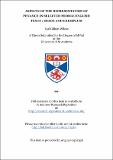Files in this item
Aspects of the representation of penance in selected Middle English texts : image and exemplum
Item metadata
| dc.contributor.advisor | Johnson, Ian | |
| dc.contributor.author | Wilcox, Karl Gilbert | |
| dc.coverage.spatial | vi, 235 p. | en_US |
| dc.date.accessioned | 2018-07-11T08:04:21Z | |
| dc.date.available | 2018-07-11T08:04:21Z | |
| dc.date.issued | 1991-07 | |
| dc.identifier.uri | https://hdl.handle.net/10023/15218 | |
| dc.description.abstract | In this dissertation Middle English figural and narrative representations of penance are assessed for their rhetorical function in the teaching of penance and their intended influence, as representational modes, upon lay understandings of penitential theory. Central to the argument is the view that the anatomised or schematic figural res functions in Middle English works of religious instruction as a paradigmatic memory image which both structures the text and works to "move" the reader's affects towards a more pious disposition. Culturally and ideologically homologous with the distinction and figural res (generally drawn from Scripture), the paradigmatic memory image performs a vital bridging role between the understanding of doctrine and its realisation in practical terms. Furthermore, the use of such schematic imagery contributes towards the integration of penance with other elements of doctrine such as the gifts of the Holy Spirit, Pater noster, and seven vices and virtues. The remedial role of penance as a dynamic mechanism to extirpate vice is made more explicit and efficacious by the sophistication and sensitivity to audience needs with which such integrated materials were compiled. The use of the exemplum i.e. exemplary narrative in the representation of penance is considered for its mnemonic utility in moving the affects. However, unlike the schematic image, the use of the exemplum for the teaching of penance requires the addition of a didactic moralization to ensure that the audience does not misinterpret the narrative. A variety of methods for the employment of moralizations is identified, and their usefulness, in terms of doctrinal consistency and possible audience responses, is assessed. | en_US |
| dc.language.iso | en | en_US |
| dc.publisher | University of St Andrews | |
| dc.subject.lcc | PR275.P3W5 | |
| dc.subject.lcsh | English literature--Middle English, 1100-1500--History and criticism | en |
| dc.subject.lcsh | Penance in literature | en |
| dc.subject.lcsh | Outlaws in literature | en |
| dc.title | Aspects of the representation of penance in selected Middle English texts : image and exemplum | en_US |
| dc.type | Thesis | en_US |
| dc.type.qualificationlevel | Doctoral | en_US |
| dc.type.qualificationname | MPhil Master of Philosophy | en_US |
| dc.publisher.institution | The University of St Andrews | en_US |
This item appears in the following Collection(s)
Items in the St Andrews Research Repository are protected by copyright, with all rights reserved, unless otherwise indicated.

